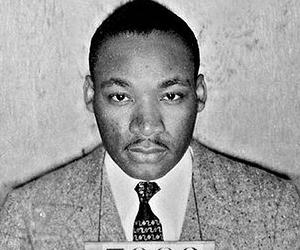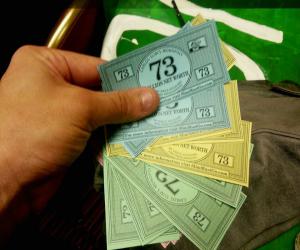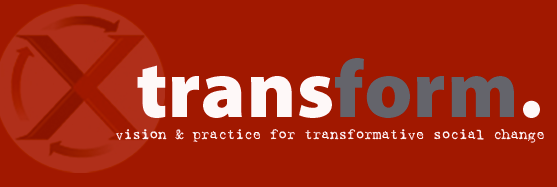The science fiction that is most important is that which situates itself at a point of struggle.
This article is the first in Transformation's new series on Utopia and Science Fiction.
Science Fiction (sf) is important. It allows us to imagine a present that is different from ours, where the future calls to us in the here and now.
When we imagine the future it is often with a longing for a better place, a kind of reverse nostalgia. We imagine a post-conflict world, a utopia.
But perfect future utopias hold no real ground in the present. A utopia cannot call to action, cannot herald the struggle needed in the now. The very idea of struggle, of action, is prohibited in these ideal futures and so some of the most radical and affecting sf writing imagines futures, which may be after conflict, after struggle, better, but are nonetheless ambiguous as desired sites of lived experience.
We need time travel – to hear this communication from the future, and to allow our bodies to enter alternate pasts. In this piece we travel to the moment after a failed revolution – the decade following 1968 - to excavate moments of struggle, revolution and change. These are moments of future(s) from a recent past, which call out to our present. Situating a non-linear relationship between past(s), present(s) and future(s) is a necessary task of sf: writing a queer time and queer histories.
During the 1970s a number of so-called feminist utopias were written in quick succession - that is texts which hinge on the production of an imaginary space in which women and/or femininity are privileged, or in which there is an abolition of binary sexual difference altogether.
The volume of this feminist utopian writing from the 1970s suggests acceptance, a ubiquity of similar texts. However, there was great resistance to these alternate visions within the publishing industry, especially within the traditionally male-dominated arena of sf.
Joanna Russ’ award winning story ‘When it Changed’ is set in the woman-only utopia of Whileaway (1972), which is intruded upon by men from another world. The piece was rejected by most editors until it ended up in the anthology Again, Dangerous Visions. Its editor, Harlan Ellison, guffawed in his introduction to the piece that Russ looked better in a bikini than the editors who rejected her.
When Suzee McKee Charnas submitted her second novel Motherlines (1978) for publication, she was told that they would publish it only if she changed all the characters from women into men. The novel centers around a post-apocalyptic lesbian separatist site in which women have escaped abject slavery under patriarchy and live out their lives without the help of human men, reproducing via sex with their horse stallions.
As Joanna Russ herself points out, the plethora of utopic feminist sf in the 70s had far less to do with the publishing industry than with the development of second wave feminism and its focus on new possibilities for sexual and reproductive lives. For Russ the ‘mini-boom’ of feminist utopias were “not only contemporaneous with the modern feminist movement but made possible by it”.
Not only were Joanna Russ and writers such as Monique Wittig deeply involved in second wave feminism, many of the key texts contained elements of science fiction themselves—futuristic cybernetics (the science of communication and operating systems in both people and things) in Shulamith Firestone’s The Dialectic of Sex and parthenogenesis (reproduction without male fertilization) in Valerie Solanas' S.C.U.M. Manifesto.
Sf is often set at a time after: after an apocalypse, a wasting, a revolution. Often these post sites appear utopian; that is, they present surfaces of an ideal, beautiful and better world. However, while these after-sites are necessary to show us sites of post-capitalism, post-gender worlds in which the arbitrary binary categorisation of gender and sexual difference is abolished, and post-masculinity futures where men and manhood as they are performed today are destroyed along with violence against women; utopias are still always imaginary, unreal; nowhere places.
The originating Utopia of Thomas Moore’s 16th century novel was founded by King Utopos, who cut off the peninsula from the mainland, making it into an island. Utopias are, like their primary ancestor, closed systems, functioning perfectly without class, oppression or struggle. As islands, cauterized from the world, proper utopias are resided in by unchanging, eternal societies, a conception which is both absurd and bordering on fascism in its undemocratic and unquestioning existence.
Utopias then are in fact antithetical to science fiction. They are more like a blueprint of a future society, instructions and pictures of a post-revolutionary world rather than stories set in those worlds. Narrative relies on change, process and struggle, all things that cannot happen within a utopia in which struggle, need and desire have been banished.
Instead of talking about utopias, we might talk about ‘future visions’ or ‘alternative visions’ set in post-revolutionary worlds. In these visions a group of people have followed the instructions of the utopian blueprint and are living out their lives within it. The struggle, which we encounter in our present is mirrored in the struggle of this perfect/imperfect future.
A good place to start is The Dispossessed (1974) by Ursula Le Guin. The novel's subtitle, ‘An Ambiguous Utopia’, formulated a new configuration of Utopian writing, which is important for understanding 1970s feminist science fiction.
In the anarchist utopia of Anarres, Le Guin creates a world based on egalitarian and post-revolutionary proposals in which there is struggle, pain and need, in which, despite its foundation on certain socialist ideals, people still suffer from corruption, pride and jealousy. The novel begins with the murder of a person who is escorting the main character, Shevek, onto a ship leaving for the capitalist world of Urras. Anarres is a place of extreme scarcity, where droughts and crop-failure mean that individuals give up their own interests and endeavours for the continuation of society.
The struggle itself has not ended once revolution has been achieved, but must be continually fought for and negotiated. Samuel Delany’s Trouble on Triton (1976) was written in dialogue with The Dispossessed, published two years previously. Its subtitle, ‘An Ambiguous Heterotopia’, makes direct reference to the novel’s own whilst ironing out the contradictions; a heterotopia, rather than being a ‘good place’, which surely can’t be ambiguous, means ‘other place’ or ‘place of differences.’
On this heterotopia on Neptune’s moon, Triton, the lead character Bron attempts to live in a post capitalist world where anyone can change gender and sexuality at will and structural oppression appears to no longer exist. However, despite living in a world ruled by individual freedoms, religious mania, the threat of war and violent subjectivities still exist, as typified in the main character themself.
Even despite the wonderful world with horses and without men, populated by the riders in Charnas’ Motherlines, we are still presented with competing and competitive tribes. This includes a group of former slaves who have very clearly internalized patriarchal power structures, and who serve a jealous and demanding matriarch, Elnoa. Elnoa controls this group of former women slaves through traditional capitalist means of wealth accumulation as well as jealousy and sexual violence.
Possibly the most explicit example of the ambiguous utopia calling out to our present is Mattapoiset, the utopia which the protagonist Consuelo visits in Marge Piercy’s Woman on the Edge of Time (1976). Gender, racism, structural oppression, class and the family have all been abolished. Everyone lives communally with little labour, speaking in a language that purposefully refuses gender differentiation. But the death penalty still exists and there are debates between those who favour eugenics and those who oppose meddling with genes.
In her own time, Consuelo is a victim of poverty and state racism, as well as gender-based violence. She is institutionalised, after defending herself and her niece from a violent man , and is threatened with invasive mind control and lobotomy. Called to the future, she is warned to resist her subjugation. She struggles against the doctors in her ward and against institutionalised racism and sexism - mirrored in the ‘future vision’ of Mattapoisett. Consuelo must fight in her present to insure the existence of Mattapoisett (as other, darker, futures are possible) as well as fight in Mattapoisett to protect that future-space; taking part in the war against the ‘shapers’ who threaten to destroy their society just as Consuelo’s freedom is threatened in the present moment. Consuelo is moved to act in her present at the moment of conflict in a possible future.
Both in the 70s and today, the sf that is most important, difficult and puncturing of the (present) status quo is that which situates itself at a point of struggle.
Le Guin puts forward her anarchist, non-sexist future, Annarres, as one where need is still abundant and where a hyper-capitalist planet still exists alongside, waiting for revolution. On Samuel Delany’s Triton, gender has been abolished, yet violent conflict is still ever-present. The matriarch in Suzee McKee Charnas’ Motherlines shows us how patriarchy is internalised and present even in spaces and worlds without men and Marge Piercy’s Mattapoisett is precarious in its very existence, as well as its future, relying on our present to help it survive.
While a call from a utopia where everyone is happy, radical, beautiful and filled with love may make for an affirming conversation, it is the urgent call made quickly in the middle of battle for a better world, which urges us through fear, desire, conflict and hope into action, rebellion: revolt.



































